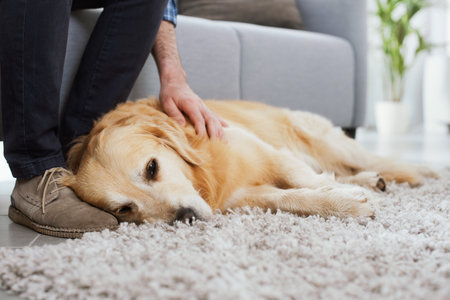Understanding When to Clean Your Dogs Ears and Eyes
Keeping your dogs ears and eyes clean is an important part of their overall health, but its essential to know when home cleaning is appropriate and when professional help is needed. In the UK, with our famously unpredictable weather and active outdoor lifestyles, dogs often find themselves in situations where routine cleaning can prevent discomfort and infections. If your dog enjoys countryside walks, trips to the seaside, or simply loves rolling in the garden, you may notice a build-up of dirt or discharge around their ears and eyes. Typical signs that indicate a gentle home clean could be beneficial include mild waxy residue in the ears, tear staining beneath the eyes (especially common in breeds like Cavaliers or Westies), or visible dust after outdoor adventures.
However, its equally vital to recognise warning signs that mean a trip to your local vet is necessary. If you spot redness, swelling, a foul odour from the ears, excessive scratching, persistent head shaking, cloudy or yellowish eye discharge, or signs of pain when touching these areas, these could signal infection or more serious health issues. Never attempt to clean deep inside your dog’s ear canal or use human products—these can do more harm than good. By learning to distinguish between everyday grime and symptoms of something more serious, British pet owners can provide safe DIY care while ensuring their furry friends get prompt veterinary attention when needed.
2. Gathering the Right British Supplies
Before you get started with cleaning your dogs ears and eyes at home, its essential to gather the correct products that are both safe for pets and easily sourced in the UK. The right supplies make all the difference in ensuring a gentle, effective, and stress-free experience for both you and your dog. Below is a helpful breakdown of dog-friendly ear and eye cleaning products commonly available from British pet shops, local pharmacies, and high street chains.
| Product Type | Recommended British Brands/Options | Where to Find | What to Look For |
|---|---|---|---|
| Ear Cleaning Solution | Beaphar Ear Cleaner, Johnsons Ear Drops for Dogs & Cats, Otodex Ear Drops | Pets at Home, Boots, Superdrug, Local Vet Practices | Alcohol-free formula, vet-approved, suitable for dogs’ sensitive ears |
| Eye Cleaning Solution | Beaphar Eye Lotion, Johnson’s Diamond Eyes, TropiClean Spa Lavish Tear Stain Remover | Pets Corner, Pets at Home, Online Pet Retailers | Mild solution, saline-based or specifically formulated for dogs |
| Cotton Pads/Balls | Sainsbury’s Basics Cotton Pads, Boots Cotton Wool Balls | Sainsbury’s, Boots, Tesco, Waitrose | Soft texture, unscented, avoid cotton buds (Q-tips) inside ears or eyes |
| Microfibre Cloths/Wipes | Paws & Presto Microfibre Towels, Animology Clean Sheets Pet Wipes | Amazon UK, Wilko, Pets at Home | Hypoallergenic wipes without harsh chemicals or added fragrance |
| Treats for Rewarding Good Behaviour | Lily’s Kitchen Training Treats, Harringtons Puppy Treats | Morrisons, Waitrose, Local Pet Shops | Small-sized treats for positive reinforcement during cleaning sessions |
Handy Tips When Shopping:
- Always double-check labels: Ensure products are specifically designed for dogs and avoid anything meant for humans or other animals.
- Ask your local vet or pet shop assistant: Staff can offer advice on trusted brands that suit British breeds’ needs.
- Avoid DIY remedies: Stick to ready-made solutions approved by UK pet health authorities for safety.
- If in doubt: Consult your veterinarian before using any new product on your dog’s ears or eyes.
Selecting the right tools is the first step towards making DIY dog ear and eye care straightforward and comfortable. With these UK-sourced essentials at hand, you’re ready to proceed with confidence to the next steps of gentle grooming.
![]()
3. Step-by-Step Guide: Cleaning Your Dog’s Ears at Home
Keeping your dog’s ears clean is an important part of their health and wellbeing, especially in the UK where our weather can often be damp, making ear infections more common. Here is a practical step-by-step guide to help you calmly and safely clean your dog’s ears at home, minimising stress for both you and your furry companion.
Gather Your Supplies
Before you begin, make sure you have everything you need: a gentle, vet-approved dog ear cleaner (available from most UK pet shops or vets), some cotton wool pads (never use cotton buds as they can damage the ear canal), and plenty of treats for positive reinforcement.
Create a Calm Environment
Choose a quiet spot in your home where your dog feels comfortable. You might want to have another person help gently hold your dog if they are nervous. Speak softly and offer reassurance throughout – this helps build trust and keeps your dog relaxed.
Step-by-Step Instructions
1. Inspect the Ears
Start by having a look at your dog’s ears. They should be pink, clean-smelling, and free from excessive wax or discharge. If you notice redness, swelling, or a bad odour, it’s best to consult your local vet before cleaning.
2. Apply Ear Cleaner
Gently lift your dog’s ear flap and squeeze a few drops of the ear cleaner into the ear canal as directed on the bottle. Be careful not to let the tip touch the ear to avoid contamination. Most British products will advise how much to use depending on your dog’s size.
3. Massage the Base
With one hand, gently massage the base of the ear for 20–30 seconds. This helps loosen any debris inside. You’ll probably hear a squelching sound – that’s perfectly normal!
4. Let Your Dog Shake
Allow your dog to shake their head; this helps bring debris up from deeper within the ear canal. It might get messy, so keep a towel handy.
5. Wipe Away Debris
Use a piece of cotton wool pad to gently wipe away any dirt or excess cleaner visible inside the ear flap and just inside the entrance to the canal. Never push anything deep into your dog’s ear.
Reward and Reassure
Finish with lots of praise and a treat to reinforce positive behaviour. Regular gentle handling like this can help make future cleans easier for both you and your pet.
British Tip:
If your dog is particularly anxious, try pairing cleaning time with a favourite activity – perhaps after a walk in the park or with a special chew toy.
4. Step-by-Step Guide: Keeping Your Dog’s Eyes Clean
When it comes to keeping your dog’s eyes clean, a gentle and consistent approach is essential, especially in the UK where weather conditions such as wind, rain, and pollen can increase the risk of irritation or discharge. Here’s a practical guide tailored to British dog owners, with special considerations for popular local breeds like the Cocker Spaniel, Labrador Retriever, and Border Collie.
Preparing for Eye Cleaning
- Gather Supplies: Use cotton pads or soft cloths (never cotton buds), a vet-approved saline solution or cooled boiled water, and treats for positive reinforcement.
- Choose the Right Time: Select a calm moment when your dog is relaxed, perhaps after a walk or play session.
- Wash Your Hands: Always start with clean hands to avoid introducing dirt or bacteria.
Step-by-Step Eye Cleaning Method
- Inspect the Eyes: Check both eyes for any redness, excessive discharge, cloudiness, or signs of discomfort. If you notice anything unusual, consult your vet before proceeding.
- Dampen the Cotton Pad: Moisten a cotton pad with the saline solution or cooled boiled water. Avoid using tap water as it may contain irritants.
- Wipe Gently: Starting from the inner corner (closest to the nose) move outward in one smooth motion. Use a separate pad for each eye to prevent cross-contamination.
- Repeat if Necessary: For breeds prone to tear staining (such as Bichon Frise or Cavaliers), you may need to repeat this process daily during high pollen seasons or after muddy walks.
- Praise and Reward: Offer a treat and plenty of praise to build positive associations with eye cleaning.
Quick Tips for British Breeds and Weather
| Breed | Common Eye Issues | Special Advice |
|---|---|---|
| Cocker Spaniel | Tear staining, debris collection due to long ears | Check eyes after walks in wooded areas; trim hair around eyes if needed |
| Labrador Retriever | Mud splashes during wet weather | Wipe eyes after outdoor activity on rainy days |
| Bichon Frise | Tear staining worsened by pollen | Increase frequency of cleaning during spring and summer |
| Border Collie | Irritation from dust and grass seeds | Inspect regularly after countryside walks; consider protective eyewear if issues persist |
Important Reminders
- If your dog shows signs of pain, persistent redness, or vision changes, seek veterinary advice immediately.
- Avoid using human eye drops or harsh chemicals—only use products recommended by your vet.
- Consistency is key—regular gentle cleaning helps prevent problems before they start.
Your dog’s comfort and health are paramount. By following these simple steps and adapting them to your local environment and breed needs, you’ll keep your dog’s eyes bright, comfortable, and healthy all year round.
5. Common Mistakes to Avoid
When it comes to cleaning your dog’s ears and eyes at home, even the most well-intentioned UK pet owners can make mistakes that lead to discomfort or potential health issues. Let’s look at some frequent errors and how you can avoid them to keep your furry friend happy and healthy.
Over-cleaning or Using the Wrong Products
A common slip-up is cleaning too often or using harsh solutions not meant for dogs. Over-cleaning can strip away natural oils, causing irritation or infections. Always use vet-approved, canine-specific products and follow recommended frequencies—generally once a week for ears and only as needed for eyes.
Poor Technique and Inadequate Restraint
Many owners insert cotton buds deep into the ear canal or scrub around the eyes too vigorously. This risks injury and distress. Instead, gently wipe the outer ear with a damp cotton pad and clean around the eyes with soft, lint-free cloths, always moving away from the eye itself. Ensure your dog is calm and secure before starting to prevent sudden movements.
Ignoring Warning Signs
It’s easy to overlook early symptoms of infection such as redness, swelling, unusual odours, or excessive discharge. If you notice any of these signs, avoid DIY cleaning and consult your local vet promptly—delaying professional care could worsen your dog’s condition.
Using Human Products or Home Remedies
Avoid using human wipes, baby oil, or homemade mixtures like vinegar solutions; these are not tailored for canine needs and may cause more harm than good. Stick to reputable pet brands available from UK vets or trusted pet shops.
Neglecting Regular Checks
Some British owners forget to check their dog’s ears and eyes until there’s a visible problem. Make routine inspections part of your grooming schedule—this proactive approach helps catch issues early and keeps your pup comfortable year-round.
By steering clear of these pitfalls and following UK guidelines for safe ear and eye care, you’ll ensure your dog stays bright-eyed, healthy-eared, and ready for every adventure together.
6. When to Seek Professional Help
While regular at-home cleaning of your dog’s ears and eyes can help maintain their health, it’s important to recognise when it’s time to stop the DIY approach and consult a British vet. Not every problem can be solved with home care, and acting promptly can prevent minor issues from turning into more serious conditions.
Warning Signs That Require Veterinary Attention
If you notice any of the following symptoms, it’s best to book an appointment with your local vet:
- Persistent redness, swelling, or discharge from the ears or eyes
- Strong or unpleasant odour coming from the ears
- Excessive scratching, pawing, or rubbing of the ears or eyes
- Frequent head shaking or tilting
- Visible wounds, sores, or growths in or around the ears/eyes
- Your dog appears in pain, is unusually sensitive to touch, or becomes lethargic
Why Prompt Action Matters
Ignoring these signs could lead to complications such as chronic infections, hearing loss, or even vision impairment. Early intervention by a professional ensures your pet receives appropriate treatment and minimises discomfort.
Finding Local Veterinary Support in the UK
The UK is home to a robust network of veterinary practices. You can find a registered vet through the Royal College of Veterinary Surgeons (RCVS) website. Many communities also have animal charities like the RSPCA and Blue Cross that offer advice and services if needed. If your dog requires urgent care outside normal hours, most regions provide emergency veterinary clinics—search online for “emergency vet near me” or check with your regular practice for out-of-hours contacts.
Building a Relationship with Your Vet
Establishing a good rapport with your local vet not only helps in emergencies but also provides ongoing support for your dog’s overall wellbeing. Don’t hesitate to seek advice; British vets are well-versed in supporting both owners and their pets with kindness and expertise.
Remember: while DIY cleaning is a valuable routine, knowing when to seek professional help is key to keeping your dog happy and healthy within British standards of pet care.


